World War II
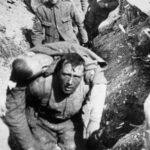 War is an ugly business, and the men and women who fight in wars are subjected to great stress and anxiety. These days, most of us recognize the term, PTSD (Post Traumatic Stress Disorder). We also recognize that a person doesn’t have to be in a war situation to have PTSD. Any traumatic event can trigger PTSD, and the symptoms of this disorder can be devastating. In fact, PTSD can result in things like suicide, attacks on others, institutionalization, or isolation.
War is an ugly business, and the men and women who fight in wars are subjected to great stress and anxiety. These days, most of us recognize the term, PTSD (Post Traumatic Stress Disorder). We also recognize that a person doesn’t have to be in a war situation to have PTSD. Any traumatic event can trigger PTSD, and the symptoms of this disorder can be devastating. In fact, PTSD can result in things like suicide, attacks on others, institutionalization, or isolation.
During World War II, PTSD (then known as Shell Shock) first came to the attention of the military leaders. On October 4, 1944, General Dwight D Eisenhower distributed to his combat units a report by the US Surgeon General that revealed the hazards of prolonged exposure to combat. The then General’s report read, “[T]he danger of being killed or maimed imposes a strain so great that it causes men to break down. One look at the shrunken, apathetic faces of psychiatric patients…sobbing, trembling, referring shudderingly to ‘them shells’ and to buddies mutilated or dead, is enough to convince most observers of this fact.” General Eisenhower had been on the battlefield, and so, knew firsthand of the “attacks” on the minds and emotions of these poor soldiers.

After evaluation of many cases of “Shell Shock” in the hospital wards, the American commanders came to the conclusion that the average soldier could last about 200 days in combat before suffering serious psychiatric damage. They looked into the fact that British commanders used a rotation method, pulling soldiers out of combat every 12 days for a four-day rest period, thereby enabling British soldiers to put in 400 days of combat before being deleteriously affected. The Surgeon General’s report went on to lament the fact that a “wound or injury is regarded, not as a misfortune, but a blessing.” Now, when a wound is considered a blessing, you know that things have taken a serious turn for the worst in the area of morale. That basically means that the soldiers will do just about anything to get off the battlefield. For them, death isn’t far from being acceptable either. General Eisenhower and the military leaders of that era could see that the war was clearly taking a toll on more than just men’s bodies. The far greater toll was on their minds and emotions.
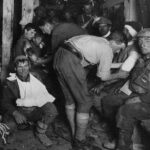 While I can see that the idea of a rotation, or a limited period of exposure to the battlefield could sound like a viable solution, in reality is is only a partial solution, and one that probably won’t really work. While the time spent on the battlefield can cause fatigue, both mentally and physically, it only takes one event to change the mental status of a person. Even a strong person is going to be effected by the horrific death of a comrade at the hands of a land mine. Yes, their own wounds would get them off the battlefield, but that will not take away the pictures of blood and death they have see on the battlefield. To take the soldiers off the battlefield after 200 days is a noble effort, but it is not likely to solve the problem of Shell Shock in the way that they had hoped. I guess that main thing is that they knew about it and were trying to fix it.
While I can see that the idea of a rotation, or a limited period of exposure to the battlefield could sound like a viable solution, in reality is is only a partial solution, and one that probably won’t really work. While the time spent on the battlefield can cause fatigue, both mentally and physically, it only takes one event to change the mental status of a person. Even a strong person is going to be effected by the horrific death of a comrade at the hands of a land mine. Yes, their own wounds would get them off the battlefield, but that will not take away the pictures of blood and death they have see on the battlefield. To take the soldiers off the battlefield after 200 days is a noble effort, but it is not likely to solve the problem of Shell Shock in the way that they had hoped. I guess that main thing is that they knew about it and were trying to fix it.
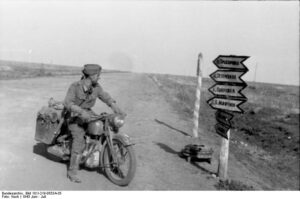 The German Kradmelder, motorcycle dispatch rider in English, could be used at any time in history, but in this case, they were used during World War II, specifically on the Eastern Front. The Eastern Front of World War II was a theatre of conflict between the European Axis powers against the Soviet Union (USSR), Poland and other Allies, which encompassed Central Europe, Eastern Europe, Northeast Europe (Baltics), and Southeast Europe (Balkans) from June 22, 1941 to May 9, 1945. The Soviet Union called it the Great Patriotic War, but everyone else called it the Eastern Front.
The German Kradmelder, motorcycle dispatch rider in English, could be used at any time in history, but in this case, they were used during World War II, specifically on the Eastern Front. The Eastern Front of World War II was a theatre of conflict between the European Axis powers against the Soviet Union (USSR), Poland and other Allies, which encompassed Central Europe, Eastern Europe, Northeast Europe (Baltics), and Southeast Europe (Balkans) from June 22, 1941 to May 9, 1945. The Soviet Union called it the Great Patriotic War, but everyone else called it the Eastern Front.
Dispatch riders were used by armed forces to get information from headquarters to the military units. They often didn’t have radios, and depending on the message, they might not have trusted the airwaves with some of the top secret messages. The Nazi Regime never really cared about its soldiers or its people, so the Kradmelder were sent out in the heat of summer or the frigid temperatures of winter. They were expendable, and that was all there was to it. Nevertheless, they played a vital role at a time when telecommunications were limited and insecure. They were also used to deliver carrier pigeons. The pigeons were used to send information back to headquarters, concerning the current situations on the front.
This type of dispatch was essential, but riding on an exposed vehicle in the Russian Winter, was brutal, and even deadly sometimes. During the winter the riders had better have protective clothing, or they could freeze to death.  The Kradfahrer (motorcycle rider) might wear a sentry’s fur-lined overcoat, heavy mittens, the fur-lined cap of the reversible winter suit, which is no doubt being worn beneath the overcoat, and a gas-mask for face protection…with the air filter canister removed from the gas-mask. Special extra eyepiece lens were issued for cold weather to prevent fogging by creating an airspace between the two lens.
The Kradfahrer (motorcycle rider) might wear a sentry’s fur-lined overcoat, heavy mittens, the fur-lined cap of the reversible winter suit, which is no doubt being worn beneath the overcoat, and a gas-mask for face protection…with the air filter canister removed from the gas-mask. Special extra eyepiece lens were issued for cold weather to prevent fogging by creating an airspace between the two lens.
In the summer, the German Kradmelder might wear his rubberized coat (Kradmantel) wrapped and buttoned around his legs to keep dirt and dust off his uniform. Personally, I can’t imagine wearing a rubberized coat in the summer simply to keep the dust off of a uniform. The rider would surly be melting from the heat, but the regime would require that the uniform be neat and clean at all times…even if it was soaked in sweat!! During World War II, the German military was the largest employers of motorcycles. On June 22, 1941 Germany launched its Operation Barbarossa, the 3-million-man invasion of the Soviet Union. The Kradmelder served a variety of functions including chauffeur service for officers, delivering dispatches, hot meals, as scouting patrols, as point vehicles taking the brunt of battle, sometimes as specially equipped tank destroyers. As with all motorcyclists, there was a kinship among these soldiers who called themselves “Kradmelder.” They bravely rode exposed without the armor plating of the Panzers Tanks and without the safety of hundreds of foot soldiers beside them. They were moving targets and sniper magnets. They never knew when they would encounter mine fields, artillery fire, and strafing aircraft, but they bravely went, because Hitler’s orders must be carried out…even if they died trying.
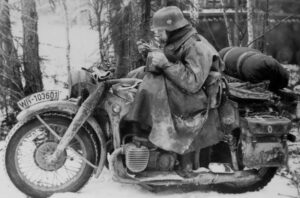 Besides the known enemy, there was another enemy…the Russian weather. As Autumn approached, the roads had turned into nearly impassable bogs, the fields over which the motorcycles traveled turning in to “seas of jelly three feet more deep.” If that weren’t bad enough, Winter brought falling temperatures, often down to -40° Fahrenheit, causing engine oil and exposed soldiers froze solid. The “lucky” German Kradmelder benefited from special heating systems grafted onto their bikes, including foot and hand warmers. Still there were those who did not have these things, and even these things didn’t totally protect the rider. By the end of World War II, many if not most of the motorcycles, along with their riders, simply never returned home.
Besides the known enemy, there was another enemy…the Russian weather. As Autumn approached, the roads had turned into nearly impassable bogs, the fields over which the motorcycles traveled turning in to “seas of jelly three feet more deep.” If that weren’t bad enough, Winter brought falling temperatures, often down to -40° Fahrenheit, causing engine oil and exposed soldiers froze solid. The “lucky” German Kradmelder benefited from special heating systems grafted onto their bikes, including foot and hand warmers. Still there were those who did not have these things, and even these things didn’t totally protect the rider. By the end of World War II, many if not most of the motorcycles, along with their riders, simply never returned home.
 Harvey Ball was a commercial artist from Worcester, Massachusetts. You may not know him, but everyone knows what he created…the smiley face. Harvey Ross Ball was born on July 10, 1921 the third of six children to Ernest G Ball and Christine “Kitty” Ross Ball. Ball’s artistic skills presented early. As a student at Worcester South High School, he decided to become an apprentice to a local sign painter. Later he attended the Worcester Art Museum School, where he studied fine arts, however, it was not in the fine arts that Ball’s fame emerged. He is recognized as the designer of a popular smiley graphic picture, which became an enduring and notable international icon.
Harvey Ball was a commercial artist from Worcester, Massachusetts. You may not know him, but everyone knows what he created…the smiley face. Harvey Ross Ball was born on July 10, 1921 the third of six children to Ernest G Ball and Christine “Kitty” Ross Ball. Ball’s artistic skills presented early. As a student at Worcester South High School, he decided to become an apprentice to a local sign painter. Later he attended the Worcester Art Museum School, where he studied fine arts, however, it was not in the fine arts that Ball’s fame emerged. He is recognized as the designer of a popular smiley graphic picture, which became an enduring and notable international icon.
Ball worked for a local advertising firm after World War II. Then he decided to start his own business, which he called Harvey Ball Advertising, in 1959. He designed the smiley in 1963. The State Mutual Life Assurance Company of Worcester, Massachusetts, now known Hanover Insurance, had purchased Guarantee Mutual Company of Ohio. After the merger, employee morale was pretty  low. The company decided to try to boost morale, so they asked Ball to come up with an image that would help. What he created was a smiley face, with one eye bigger than the other. The creation took Ball ten minutes, and the executives liked it immediately. They paid Ball a mere $45 for his creation.
low. The company decided to try to boost morale, so they asked Ball to come up with an image that would help. What he created was a smiley face, with one eye bigger than the other. The creation took Ball ten minutes, and the executives liked it immediately. They paid Ball a mere $45 for his creation.
The smiley face became part of the company’s friendship campaign, and State Mutual handed out 100 smiley pins to employees. The aim was to get employees to smile while using the phone and doing other tasks. The buttons became popular, with orders being taken in lots of 10,000. More than 50 million smiley face buttons had been sold by 1971, and the smiley has been described as an international icon. As for Ball, well…he never applied for a trademark or copyright of the smiley and that $45 was all he ever got for his trouble. I don’t suppose that did much for his morale. Nevertheless, State Mutual didn’t make any money from the design either. According to Ball’s son, Charles, his father never regretted not registering the copyright. Charles Ball said, “he was not a money-driven guy, he used to say, ‘Hey, I can only eat one steak at a time, drive one car at a time.'”

Ball had a heart for children, and founded the World Smile Foundation in 1999, a non-profit charitable trust that supports children’s causes. Then, he came up with World Smile Day. It was a great idea, I think. How nice it is to celebrate a day dedicated to putting a smile on your face and sharing that great smile with others. The first World Smile Day was celebrated in 1999. It’s been held annually on the first Friday of October since then. After Harvey died in 2001, the “Harvey Ball World Smile Foundation” was created to honor his name and memory. The slogan of the Smile Foundation is “improving this world, one smile at a time.” The Foundation continues to be the official sponsor of World Smile Day each year. We should all consider that slogan.

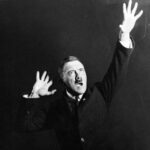 Recently, I ran across an article about drug use in among the Nazi regime. The article really caught my attention, because in many ways drug use among the Nazis made sense. The things they did to people would have been much easier if they were under the influence of drugs…mostly because they would be less likely to remember what they had done, and if they remembered, they would be less likely to care about what they had done. Drugs tend to dull the senses, and in many cases that makes the person relaxed and calm, but there are some drugs that make the person violent too. The article started out saying, “‘You can learn a lot about a culture from its drug use.’ Robert McAlmon, an American author living in Berlin during the tumultuous Weimar years, marveled that ‘dope, mostly cocaine, was to be had in profusion’ at ‘dreary night clubs’ where ‘poverty-stricken boys and girls of good German families sold it, and took it.’”
Recently, I ran across an article about drug use in among the Nazi regime. The article really caught my attention, because in many ways drug use among the Nazis made sense. The things they did to people would have been much easier if they were under the influence of drugs…mostly because they would be less likely to remember what they had done, and if they remembered, they would be less likely to care about what they had done. Drugs tend to dull the senses, and in many cases that makes the person relaxed and calm, but there are some drugs that make the person violent too. The article started out saying, “‘You can learn a lot about a culture from its drug use.’ Robert McAlmon, an American author living in Berlin during the tumultuous Weimar years, marveled that ‘dope, mostly cocaine, was to be had in profusion’ at ‘dreary night clubs’ where ‘poverty-stricken boys and girls of good German families sold it, and took it.’”
Over the years, a number of drugs have been banned, due to the danger of their use, the reactions of those taking them, or just that they are now deemed illegal. Cocaine was banned in 1924, but that has not really stopped it’s use. Like most drugs, if there is a “market” for it, someone will find a way to get the drug to the “customer.” Meth has become so easy to make and uses common (but poisonous) ingredients, so it has become the drug of choice for many drug addicts today. Some prescription drugs are addictive, and have become a part of the drug trafficking world too. Drugs like Opioids and Morphine are fairly easy to obtain from a doctor, because they hare used for many injuries and common ailments. Then they become addicted, and when they can no longer get a prescription for those drugs, they move on to illegal drugs.
Strangely, when the Nazis rose to power, illegal drug consumption actually fell. The Nazis regarded drugs as “toxic” to the German body. Drug users were given prison sentences, and addicts were classed…along with Jews, gypsies and homosexuals…as undesirable social elements. By the end of the 1930s, the Nazi pharmaceutical companies had turned away from opioids and cocaine, and moved towards synthetic stimulants. These could be produced entirely within Germany, per Nazi directive, of course. More money in the pocket of Hitler’s regime. “The transition from cabaret cocaine to over-the-counter meth helped fuel what German journalist Norman Ohler in his new book Blitzed: Drugs in the Third Reich calls the ‘developing performance society’ of the early Nazi era, and primed Germany for the war to come.”
I’m sure that the Third Reich, while calling it “developing performance society,” knew that the the use of these drugs was going to make the people taking the drugs more compliant to the government. Once a person is addicted to a drug, many will do anything to get a “fix,” including theft, robbery, breaking and entering, selling themselves, and even begging to get more. In 1937, the German pharmaceutical company called Temmler-Werke introduced Pervitin, which was a methamphetamine-based stimulant. The formula was developed by Dr Fritz Hauschild. He went on to pioneer East Germany’s sports doping program. Within a few months, this variant of crystal meth was available without a prescription, and was even sold in boxed chocolates. It was also widely adopted by people from all walks of life to elevate mood, control weight gain, and increase productivity. Pervitin’s success as an over-the-counter “wonder drug” caused a rebound in the country’s economic status after the war. The country came out of an economic depression to nearly full employment. Marketing for Pervitin claimed it would help “integrate shirkers, malingerers, defeatists, and whiners” into the rapidly expanding workforce. Students took it to cram for exams, while housewives took it to stave off depression. Pervitin use was so common that it became a normal part of life in the early Third Reich. For the military personnel of Hitler’s army, the chemical was a great weapon to fight the so-called “war on exhaustion.” The troops started relying on the “tank chocolate” to keep them alert for days on end. Before long, Nazi medical 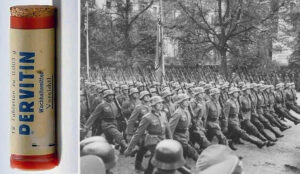 officials became increasingly aware of Pervitin’s risk factor. The tests performed on soldiers found that critical thinking skills declined the longer they stayed awake, even if the short-term gains were appealing enough. Even after drug sales to the general public were restricted in April 1940, the German Army High Command issued the so-called “stimulant decree,” ordering Temmler to produce 35 million tablets for military use. Of course, we know now that methamphetamine use is not only dangerous, but often deadly. The addictive effects alone can ruin lives. I don’t suppose Hitler cared much about that, as long as his troops obeyed his commands. I wonder how many men lost their lives because of the drug.
officials became increasingly aware of Pervitin’s risk factor. The tests performed on soldiers found that critical thinking skills declined the longer they stayed awake, even if the short-term gains were appealing enough. Even after drug sales to the general public were restricted in April 1940, the German Army High Command issued the so-called “stimulant decree,” ordering Temmler to produce 35 million tablets for military use. Of course, we know now that methamphetamine use is not only dangerous, but often deadly. The addictive effects alone can ruin lives. I don’t suppose Hitler cared much about that, as long as his troops obeyed his commands. I wonder how many men lost their lives because of the drug.

 After making a move from Casper, Wyoming to Cheyenne, Wyoming on June 5th, my nephew, Jason Sawdon is settling into his new job and promotion, and great hours for a family man, with the Wyoming Highway Patrol. Jason has had a long and successful career with the WHP, and this promotion to Sergeant of Equipment and Technology, is the next step in his decorated career. Jason’s job is to coordinate and test the equipment to make sure it is safe and effective for use in the WHP. He is so well respected and such a help to all who need him, which is no surprise considering his helpful nature. With the promotion comes a great schedule for a family man, with a wife who works from home. Jason now has evenings, weekends, and holidays off, so he and his girls…my niece, Jessi and their daughter, Adelaide, as well as, their dog, Daisy, have been busy exploring the Cheyenne area when they aren’t doing some DIY projects on their home.
After making a move from Casper, Wyoming to Cheyenne, Wyoming on June 5th, my nephew, Jason Sawdon is settling into his new job and promotion, and great hours for a family man, with the Wyoming Highway Patrol. Jason has had a long and successful career with the WHP, and this promotion to Sergeant of Equipment and Technology, is the next step in his decorated career. Jason’s job is to coordinate and test the equipment to make sure it is safe and effective for use in the WHP. He is so well respected and such a help to all who need him, which is no surprise considering his helpful nature. With the promotion comes a great schedule for a family man, with a wife who works from home. Jason now has evenings, weekends, and holidays off, so he and his girls…my niece, Jessi and their daughter, Adelaide, as well as, their dog, Daisy, have been busy exploring the Cheyenne area when they aren’t doing some DIY projects on their home.
Having weekends and holidays off has given the family lots of time for trips, so this summer, they have visited Laramie, Michigan, Denver, Casper, the Snowy Range, Medicine Bow National Forest, and Guernsey State Park. It has also been fun for them to explore their new area and Jason has had a blast doing it. The summer has 
 flown by, and they have been so busy that they didn’t get to go camping as much as they would have liked, but they are going camping this weekend, so that will be fun.
flown by, and they have been so busy that they didn’t get to go camping as much as they would have liked, but they are going camping this weekend, so that will be fun.
My niece, Kellie Hadlock, Jessi’s sister tells me that Jason is the most helpful person on the planet! He can fix anything. It’s always nice to have a handyman around the house. Jason is a good cook too, even if he made the hottest tacos on the planet…totally by accident, of course, the last time Kellie visited them. Hot is a relative concept, because there are those of us who believe that it isn’t hot enough, unless it makes your lips numb and your nose run…me included. I suppose there could be a level called “too hot,” but I really can’t say I have found that yet, but then I haven’t tried every pepper. Maybe someday.
Jason is a very hands on dad, often helping daughter, Addi build things and learn new things. Addi just adores her daddy. Recently, the Sawdon and Hadlock families got the chance to go to an air show at the Cheyenne 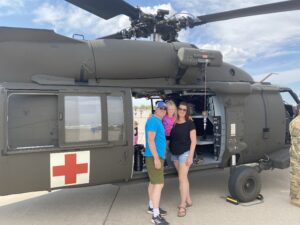
 Regional Airport, and then they got to tour the vintage World War II planes there, as well as the more modern helicopters. They had a wonderful time going through them since my dad, Jessi’s grandpa, Al Spencer served as top turret gunner on a B-17, based in Great Ashfield, Suffolk, England during the war. Going through those planes is always a sentimental journey for our family. Now, the next generation will get to love it too. Today is Jason’s birthday. Happy birthday Jason!! Have a great day!! We love you!!
Regional Airport, and then they got to tour the vintage World War II planes there, as well as the more modern helicopters. They had a wonderful time going through them since my dad, Jessi’s grandpa, Al Spencer served as top turret gunner on a B-17, based in Great Ashfield, Suffolk, England during the war. Going through those planes is always a sentimental journey for our family. Now, the next generation will get to love it too. Today is Jason’s birthday. Happy birthday Jason!! Have a great day!! We love you!!
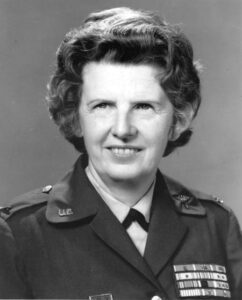 War heroes come in many forms, and Colonel Ruby Bradley was one of the great ones. Born on December 19, 1907 in the small town of Spencer, West Virginia the daughter of Fred O Bradley and Bertha Welch. Bradley was the fifth of six children, and she was raised on a farm in Roane County, West Virginia. From a young age, she was taught to work hard on her parents farm. Farm kids are not strangers to hard work. The farm animals and the crops require that every member of the family had to do their part, meaning men, women, and children to assume many roles such as manual labor. From an early age, Ruby understood the worth of manual labor and hard work. She was a hard worker and she was not a quitter.
War heroes come in many forms, and Colonel Ruby Bradley was one of the great ones. Born on December 19, 1907 in the small town of Spencer, West Virginia the daughter of Fred O Bradley and Bertha Welch. Bradley was the fifth of six children, and she was raised on a farm in Roane County, West Virginia. From a young age, she was taught to work hard on her parents farm. Farm kids are not strangers to hard work. The farm animals and the crops require that every member of the family had to do their part, meaning men, women, and children to assume many roles such as manual labor. From an early age, Ruby understood the worth of manual labor and hard work. She was a hard worker and she was not a quitter.
Bradley’s life took a drastic turn during World War II. Prior to World War II, as a career Army nurse, Colonel Ruby Bradley served as the hospital administrator in Luzon in the Philippines. When the Japanese invaded the Philippines, three weeks after the attack on Pearl Harbor, she and a doctor and fellow nurse hid in the hills. Unfortunately, they were turned in by locals and taken to the base, which had been turned into a prison camp. In 1943, Bradley was moved to the Santo Tomas Internment Camp in Manila. It was there that she and several other imprisoned nurses earned the title “Angels in Fatigues” from fellow captives. For the next several months, she provided medical help to the prisoners and sought to feed starving children by shoving food into her pockets whenever she could, often going hungry herself. As she lost weight, she used the room in her uniform for smuggling surgical equipment into the prisoner-of-war camp. At the camp she assisted in 230 operations and helped to deliver 13 children. Bradley and her staff spent three years treating fellow POWs, delivering babies, and performing surgery. They also smuggled supplies to keep the POWs healthy, although Bradley herself weighed a mere 84 pounds when the Americans liberated the camp in 1945.
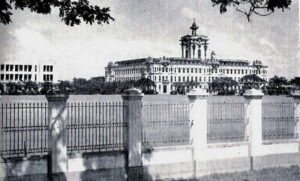
After the war, Bradley served in the Korean War as the 8th Army’s chief nurse on the front lines in 1950. During a heavy fire attack, Bradley managed to evacuate all of the wounded soldiers in her care, doing so without regard for her own safety. She was the last to jump aboard the evacuation plane just as her ambulance was shelled. After her actions during that attack, she was promoted to Colonel. She retired from the Army in 1963, but worked as a supervising nurse in West Virginia for 17 years. Ruby Bradley is known as the most decorated woman in US history, having received 34 medals and citations, including Legion of Merit with oak leaf cluster, Bronze Star Medal with oak leaf cluster, Army Commendation Medal with oak leaf cluster, Prisoner of War Medal, Presidential Unit Citation with oak leaf cluster, Meritorious Unit Commendation, American Defense Service Medal with “Foreign Service” clasp, American Campaign Medal, Asiatic-Pacific Campaign Medal with two campaign stars, World War II Victory Medal, Army of Occupation Medal with “Japan” clasp, National Defense Service Medal with star, Korean Service Medal with three campaign stars, Philippine Defense Medal (Republic of Philippines) with star, Philippine Liberation Medal (Republic of Philippines) with star, Philippine Independence Medal (Republic of Philippines), United Nations Service Medal, Korean War Service Medal (Republic of Korea), and Florence Nightingale Medal (International Red Cross). Colonel Ruby Bradley died of a heart attack on May 28, 2002. She received a hero’s 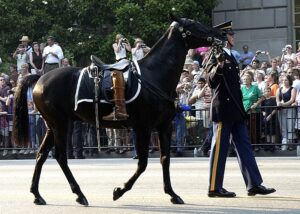 funeral with full honors at Arlington National Cemetery. “Her coffin was escorted to the grave site by six white horses, and the symbolic riderless horse followed, while the Army Band played traditional hymns. “A riderless horse (which may be caparisoned in ornamental and protective coverings, having a detailed protocol of their own) is a single horse, without a rider, and with boots reversed in the stirrups, which sometimes accompanies a funeral procession. The horse follows the caisson carrying the casket.” A firing party of seven sounded three volleys in her honor, and the flag covering her coffin was presented to a relative.” Many family members and Army soldiers paid their respects by placing roses on top of the coffin and also saluting her resting place as they left. She was 94.
funeral with full honors at Arlington National Cemetery. “Her coffin was escorted to the grave site by six white horses, and the symbolic riderless horse followed, while the Army Band played traditional hymns. “A riderless horse (which may be caparisoned in ornamental and protective coverings, having a detailed protocol of their own) is a single horse, without a rider, and with boots reversed in the stirrups, which sometimes accompanies a funeral procession. The horse follows the caisson carrying the casket.” A firing party of seven sounded three volleys in her honor, and the flag covering her coffin was presented to a relative.” Many family members and Army soldiers paid their respects by placing roses on top of the coffin and also saluting her resting place as they left. She was 94.
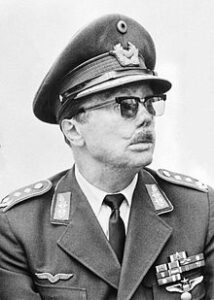 Johannes “Macky” Steinhoff was a fighter ace, flying a Luftwaffe fighter plane, during World War II. He was also a German general, and NATO official. Most of the Luftwaffe pilots did not survive to fly operationally throughout the entire World War II period of 1939 to 1945, but Steinhoff managed to do so. One of the highest-scoring pilots with 176 victories, Steinhoff was one of the first to fly the Messerschmitt Me 262 jet fighter in combat as a member of the Jagdverband 44 squadron led by Adolf Galland. Steinhoff received the Knight’s Cross of the Iron Cross with Oak Leaves and Swords, and later received the Grand Cross of the Order of Merit of the Federal Republic of Germany and several foreign awards including the American Legion of Merit and the French Legion of Honour. Steinhoff also played a role in the Fighter Pilots Conspiracy when several senior air force officers confronted Hermann Göring late in the war.
Johannes “Macky” Steinhoff was a fighter ace, flying a Luftwaffe fighter plane, during World War II. He was also a German general, and NATO official. Most of the Luftwaffe pilots did not survive to fly operationally throughout the entire World War II period of 1939 to 1945, but Steinhoff managed to do so. One of the highest-scoring pilots with 176 victories, Steinhoff was one of the first to fly the Messerschmitt Me 262 jet fighter in combat as a member of the Jagdverband 44 squadron led by Adolf Galland. Steinhoff received the Knight’s Cross of the Iron Cross with Oak Leaves and Swords, and later received the Grand Cross of the Order of Merit of the Federal Republic of Germany and several foreign awards including the American Legion of Merit and the French Legion of Honour. Steinhoff also played a role in the Fighter Pilots Conspiracy when several senior air force officers confronted Hermann Göring late in the war.
Steinhoff was born on September 15, 1913 in Bottendorf, Thuringia, the son of an agricultural mill-worker and his traditional housewife. He had two brothers, Bernd and Wolf, and two sisters, Greta and Charlotte. Steinhoff was promoted to Second Lieutenant on 1 April 1936. He married his wife Ursula on April 29, 1939 and they had a son, Wolf and a daughter, Ursula.
One would think that being one of the first pilots to fly a new airplane would be a huge honor, but flying the Messerschmitt Me 262 jet fighter was risky. It wasn’t necessarily that it crashed any more often than any other plane, but the Messerschmitt Me 262 had a rather huge flaw. The fuel tanks were located in front, under, and behind the pilot. That meant that in a crash situation with fuel on board, the pilot was immediately trapped in an inferno. As a member of Jagdverband-44 (JV-44), flying a Messerschmitt Me 262, Steinhoff was permanently disfigured after receiving major burns across most of his body when he crashed after a failed takeoff. It was such a strange situation. His flight leader’s left wheel had blown out causing him to turn and make a sharp left turn, careening into Steinhoff and causing him to run off the runway, at which point, the fuel tanks ruptured. On that fateful day, Steinhoff and the men he was going up with that day were armed with an experimental under wing rocket which among with the cannon ammunition Steinhoff was carrying. It made escape all the more difficult due to the amount ordnance exploding around him. According to ace fighter pilot and member of JV-44 Franz Stigler, “In a matter of seconds, Steinhoff had turned into a human torch.” Steinhoff was left with horrible scarring for the rest of his life and his chances of survival were slim. Against all odds, he pulled through in the end and retired as a four star general in the new German Air Force at age 59.
After his retirement, he joined the West German government’s Rearmament Office as a consultant on military aviation in 1952 and became one of the principal officials tasked with building the German Air Force during the 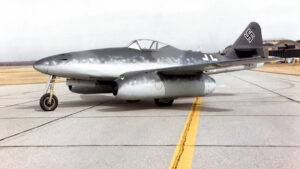 Cold War. He became the German Military Representative to the NATO Military Committee in 1960, served as Acting Commander Allied Air Forces Central Europe in NATO 1965–1966, as Inspector of the Air Force 1966–1970 and as Chairman of the NATO Military Committee 1971–1974. In retirement, Steinhoff also became a widely read author of books on German military aviation during the Second World War and the experiences of the German people at that time. On February 21, 1994, Steinhoff died in a Bonn hospital from complications arising from a heart attack he suffered the previous December. He was 80, and had lived in nearby Bad Godesberg.
Cold War. He became the German Military Representative to the NATO Military Committee in 1960, served as Acting Commander Allied Air Forces Central Europe in NATO 1965–1966, as Inspector of the Air Force 1966–1970 and as Chairman of the NATO Military Committee 1971–1974. In retirement, Steinhoff also became a widely read author of books on German military aviation during the Second World War and the experiences of the German people at that time. On February 21, 1994, Steinhoff died in a Bonn hospital from complications arising from a heart attack he suffered the previous December. He was 80, and had lived in nearby Bad Godesberg.
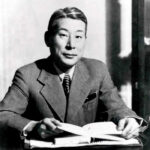 When we thing of people who were heroes for the Jewish people during World War II, we seldom think of true enemies of the Allied Nations. Still, there are people in all nations, no matter how evil the nation, who are good. One such man was Chiune Sugihara, a Japanese diplomat who served as vice-consul for the Japanese Empire in Kaunas, Lithuania. Sugihara was born on January 1, 1900 in Mino, Gifu prefecture, to a middle-class father, Yoshimi Sugihara and an upper-middle class mother, Yatsu Sugihara.
When we thing of people who were heroes for the Jewish people during World War II, we seldom think of true enemies of the Allied Nations. Still, there are people in all nations, no matter how evil the nation, who are good. One such man was Chiune Sugihara, a Japanese diplomat who served as vice-consul for the Japanese Empire in Kaunas, Lithuania. Sugihara was born on January 1, 1900 in Mino, Gifu prefecture, to a middle-class father, Yoshimi Sugihara and an upper-middle class mother, Yatsu Sugihara.
Sugihara became the vice-consul in 1939. His duties included reporting on Soviet and German troop movements, and to find out if Germany planned an attack on the Soviets and, if so, to report the details of this attack to his superiors in Berlin and Tokyo. As vice-consul, I’m sure he never expected to go against the orders of his superiors. I’m sure that he thought, as most of us do, that our country is the best one, and that our government is honorable and basically good…until we don’t. During the second world war, Sugihara made the decision…against orders from superiors…to help 6,000 Jews escape Europe by issuing transit visas to them, so that they could travel through Japanese territory. By doing this, he was risking his job and the lives of his family, but he knew that the things that were happening to the Jews were wrong, and he could not stand by and be a party to their deaths. The Jews that Sugihara helped were refugees from German-occupied Western Poland and Soviet-occupied Eastern Poland, as well as residents of Lithuania. I’m sure that Sugihara’s superiors didn’t want to anger their ally, Adolf Hitler, so they had told Sugihara to turn a blind eye to the fate of the Jewish people, and let the Nazis do what they wanted to do to them. But, Sugihara had a conscience, and he could not allow he Jews to be murdered in such a horrific fashion. He had to help as many as he could.
From July 18 to August 28, 1940, Sugihara being aware that Jewish visa applicants were in danger if they 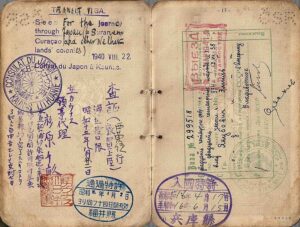 stayed behind, Sugihara decided to ignore his orders and issued ten-day visas to Jews for transit through Japan. Given his inferior post and the culture of the Japanese Foreign Service bureaucracy, this was an unusual act of disobedience. Sugihara spoke to Soviet officials who agreed to let the Jews travel through the country via the Trans-Siberian Railway…at five times the standard ticket price, of course. I guess there is no price too high…seriously. Sugihara continued to spend 18 to 20 hours a day writing hand-write visas, reportedly producing a normal month’s worth of visas each day, until September 4th, when he had to leave his post before the consulate was closed. While his time was cut short at that consulate, he had granted thousands of visas to Jews, many of whom were heads of households, thus permitting them to take their families with them. It is said that before he left, he handed the official consulate stamp to a refugee so that more visas could be forged, but his son, Nobuki Sugihara, insists that his father never gave the stamp to anyone. According to witnesses, he was still writing visas while in transit from his hotel and after boarding the train at the Kaunas Railway Station, throwing visas into the crowd of desperate refugees out of the train’s window even as the train pulled out. It was an insanely brave act, and it did not go unnoticed.
stayed behind, Sugihara decided to ignore his orders and issued ten-day visas to Jews for transit through Japan. Given his inferior post and the culture of the Japanese Foreign Service bureaucracy, this was an unusual act of disobedience. Sugihara spoke to Soviet officials who agreed to let the Jews travel through the country via the Trans-Siberian Railway…at five times the standard ticket price, of course. I guess there is no price too high…seriously. Sugihara continued to spend 18 to 20 hours a day writing hand-write visas, reportedly producing a normal month’s worth of visas each day, until September 4th, when he had to leave his post before the consulate was closed. While his time was cut short at that consulate, he had granted thousands of visas to Jews, many of whom were heads of households, thus permitting them to take their families with them. It is said that before he left, he handed the official consulate stamp to a refugee so that more visas could be forged, but his son, Nobuki Sugihara, insists that his father never gave the stamp to anyone. According to witnesses, he was still writing visas while in transit from his hotel and after boarding the train at the Kaunas Railway Station, throwing visas into the crowd of desperate refugees out of the train’s window even as the train pulled out. It was an insanely brave act, and it did not go unnoticed.
In 1985, the State of Israel honored Sugihara as one of the Righteous Among the Nations for his actions…the highest honor given to non-Jews.. He is the only Japanese national ever to receive it. The year 2020 was “The Year of Chiune Sugihara” in Lithuania. It has been estimated as many as 100,000 people alive today are the descendants of the recipients of Sugihara visas. When asked by Moshe Zupnik why he risked his career to save other people, he said simply, “I do it just because I have pity on the people. They want to get out so I let them 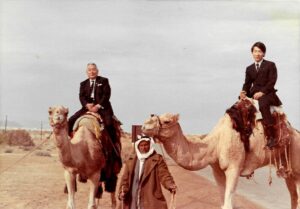 have the visas.”
have the visas.”
Chiune Sugihara died at a hospital in Kamakura, on July 31, 1986. Despite the publicity given him in Israel and other nations, Sugihara remained virtually unknown in his home country. I’m sure they didn’t consider him anything more than a criminal. Only when a large Jewish delegation from around the world, including the Israeli ambassador to Japan, attended his funeral, did his neighbors find out what he had done. His subsequent considerable posthumous acclaim contrasts with the obscurity in which he lived following the loss of his diplomatic career.
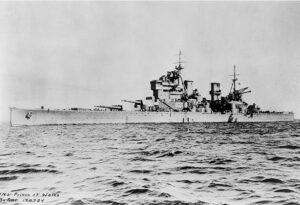
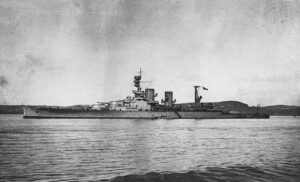 When we think about the enemies of war, we usually think of two nations that unequivocally hate each other. It is thought that every member of teach nation totally hates every member of the other, but that is not even logical. It doesn’t matter what nation you are talking about, the people of those nations are thoughts to hate each other, and many of them do, but nt all of them do. Not everyone loved war, and not everyone loves killing.
When we think about the enemies of war, we usually think of two nations that unequivocally hate each other. It is thought that every member of teach nation totally hates every member of the other, but that is not even logical. It doesn’t matter what nation you are talking about, the people of those nations are thoughts to hate each other, and many of them do, but nt all of them do. Not everyone loved war, and not everyone loves killing.
World War II was the deadliest wars in world history. It seemed that everyone hated everyone else, or at least that those from the one side (the Allied Powers) hated the other (the Axis of Evil). That wasn’t true either. The leaders probably hated each other, but the people of the nations were caught in the middle of the hatred of their leaders. Many of the people, civilians and military alike were family people, they had a love of others. Many of the people who fought in World War II had no idea of the horrors that were taking place. When they finally found out about it, they were absolutely horrified.
Still, those who fought in the war, knew some of the casualties of the war. A fighter pilot can’t fly over an expanse of an ocean battlefield and not see the losses taking place. For a fighter pilot or a bomber crew, it was not only possible to see the devastation, but they could also imagine what was going on below them as ships sink so quickly that the men onboard cannot escape. To add to the horror, the fact that these ships were his by torpedoes, bombs from the planes, bullets from the planes, and the planes themselves brought the added horror of fire and burning bodies. If a pilot let himself think about it, I think it would be possible to become physically ill at the thought of the horrors going on below them.
One fighter pilot felt that very deeply. During a sea battle in the Pacific Ocean in December 1940, two Royal Navy ships, the HMS Prince of Wales and the HMS Repulse were sunk by Japanese fighters. The scene must have been horrific for the pilots above, whether they were British or Japanese, they knew that men were dying horrific deaths below them. The loss of life so impacted on Japanese fighter pilot that he came back to the spot 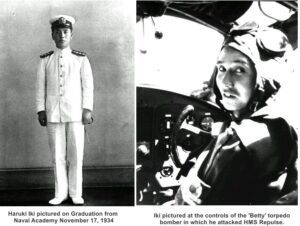
 the next day and dropped two wreaths on the water. His action was to commemorate the dead from both sides during WWII. Japanese Flight Lieutenant Haruki Iki flew to the location of the battle and dropped the two wreaths over the seas. It was a simple act, but it was also a profound act. It showed that while the nations were enemies, the people of the nations were not necessarily enemies too. It also showed that even enemies can have compassion on the other side. War is not all about hate, it is also about being caught in the middle, with no way out but to fight.
the next day and dropped two wreaths on the water. His action was to commemorate the dead from both sides during WWII. Japanese Flight Lieutenant Haruki Iki flew to the location of the battle and dropped the two wreaths over the seas. It was a simple act, but it was also a profound act. It showed that while the nations were enemies, the people of the nations were not necessarily enemies too. It also showed that even enemies can have compassion on the other side. War is not all about hate, it is also about being caught in the middle, with no way out but to fight.
 These days, most of us don’t give too much thought to the reasons for school lunches, but during the Great Depression, children might have gone to school with some potato skins, a piece of bread, or even nothing at all, if their parents didn’t have enough money to get them something. Enter the school lunch program. It’s been around for so long that these days it is just part of everyday school life. The reasons aren’t what you might think. Many people think that the Great Depression had something to do with the set up of the National School Lunch Program, but that would be wrong. The National School Lunch Program started in 1946, and it was actually due to World War II.
These days, most of us don’t give too much thought to the reasons for school lunches, but during the Great Depression, children might have gone to school with some potato skins, a piece of bread, or even nothing at all, if their parents didn’t have enough money to get them something. Enter the school lunch program. It’s been around for so long that these days it is just part of everyday school life. The reasons aren’t what you might think. Many people think that the Great Depression had something to do with the set up of the National School Lunch Program, but that would be wrong. The National School Lunch Program started in 1946, and it was actually due to World War II.
As many people know, World War II was the second deadliest war in United States history. The loss of 405,399 American lives was second only to the Civil War, in which 618,222 American lives were lost. When a nation loses so many young men to war, there can be a concern about the future and particularly about future wars. The United States government decided to address that future deficit by giving the nation’s children free meals. The theory was that if the children were given meals with proper nutrition,  there would be a healthier draft pool in the event it was ever necessary to have a draft again. That is a good idea in theory, and I’m sure that with nutritious meals they would be healthier, but it is strange to use that as a way to build an army. In a way it seems manipulative.
there would be a healthier draft pool in the event it was ever necessary to have a draft again. That is a good idea in theory, and I’m sure that with nutritious meals they would be healthier, but it is strange to use that as a way to build an army. In a way it seems manipulative.
Why do governments always seem to have an ulterior motive…about everything they do? I suppose it’s possible for them to honestly want to help people, but when you hear things like feeding the hungry, so they will make a good army, it tends to be a really big inspiration downer. The idea that had taken shape in the first place, becomes polluted by the manipulation of the government, and suddenly it just doesn’t seem so nice. Over the years, military leaders have stood up to make sure America’s youth had proper nutrition for a healthy start in life. The military discovered that at least 40% of rejected recruits were turned away for reasons related to poor nutrition. With that, I can understand that the government wanted to help. After the war ended, the military’s Selective Service Director, General Lewis Hershey, gave a speech that helped win passage of the National  School Lunch Program in 1946.
School Lunch Program in 1946.
Now, Seventy years later, the program is still a very important part of the healthy eating habits of a great number of children. School nutrition remains a national security concern. Many children consume up to half of their daily calories at school. That said, it stands to reason that healthier school nutrition will be a driving force for lowering obesity, which is the leading medical reason why more than 70 percent of the nation’s young adults cannot qualify for military service. I am not opposed to making children’s lives better, but I just don’t like the manipulation that was involved.

